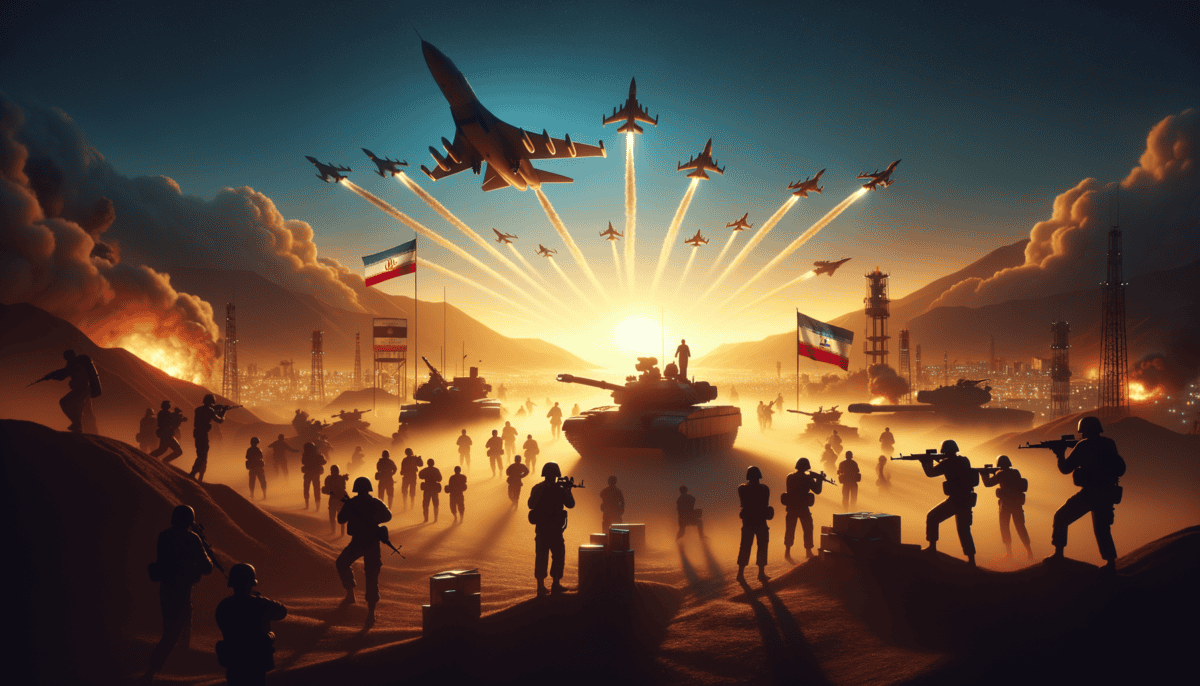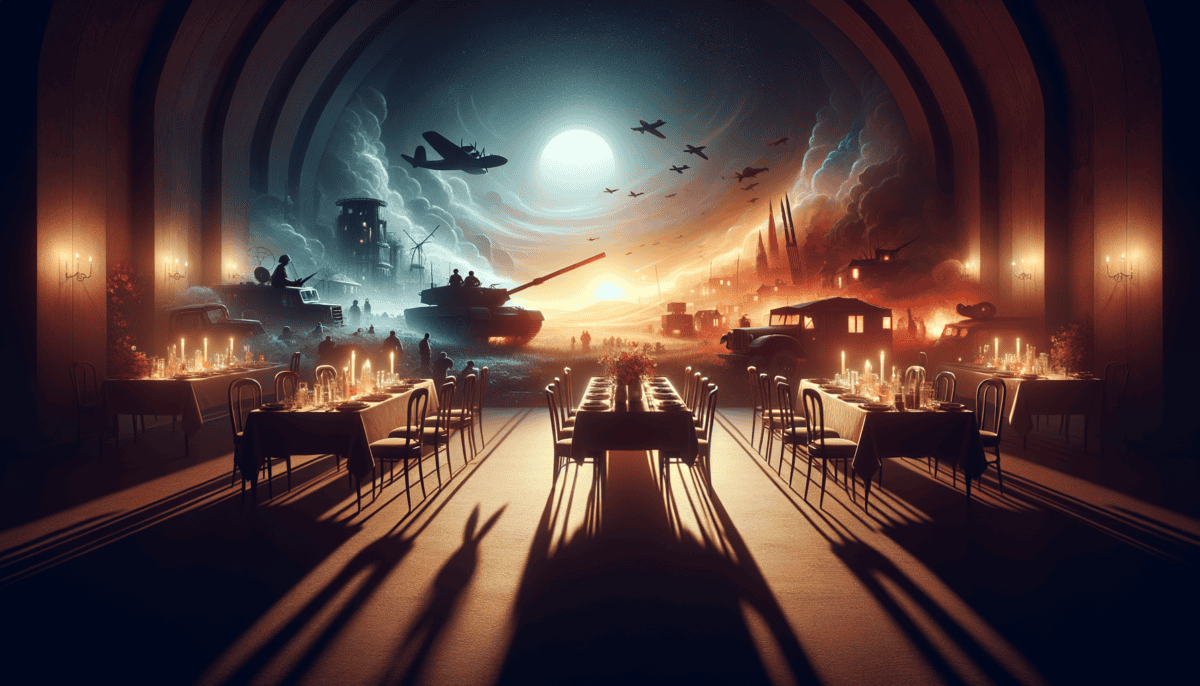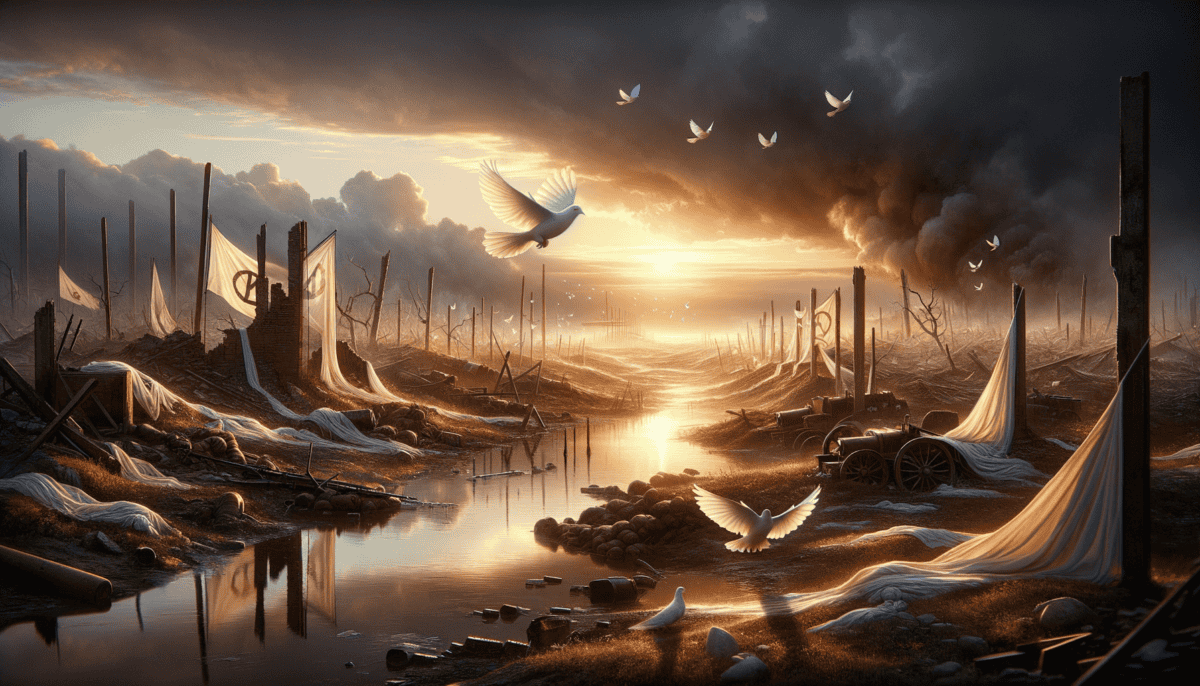The Seeds of War
In the hot desert lands of the Middle East, two countries called Iran and Iraq shared a long border. It was 1980, and dark clouds were gathering over these ancient lands.
Two Leaders, Two Dreams
Saddam Hussein ruled Iraq. He was a strong man who always wanted more power. In his fancy palace in Baghdad, he would look at maps and dream of making Iraq bigger and stronger.
"Our nation deserves more land," Saddam would tell his generals, pointing to the oil-rich areas near the border with Iran.
Across the border in Iran, a different kind of leader had just taken power. Ayatollah Khomeini wore black robes and a white beard. He had different ideas about how to run his country.
A Fight Over Land
Between these two countries ran a very important river called the Shatt al-Arab. Both Iran and Iraq wanted to control this river. It was like two kids fighting over the same toy in a playground, but much more serious.
"This river belongs to Iraq!" Saddam would shout.
"No, we have rights to it too!" Iran would answer back.
Growing Problems
Things got worse when Iran had a big change in how it was run. They started telling Iraqi people to change their government too. This made Saddam very angry.
The two countries started arguing more and more:
• Over where the border should be
• About who owned which islands
• About who should control the important river
• About different ways of thinking about religion
The Last Peaceful Days
By September 1980, the air was thick with tension. Soldiers on both sides cleaned their weapons and waited. Families near the border could feel something bad was about to happen.
Little Ahmed, a young Iraqi boy living near the border, asked his father, "Why are there so many soldiers in our town?"
His father looked worried as he answered, "Sometimes grown-ups forget how to talk to each other nicely, son."
In Iran, a young girl named Maryam watched military trucks drive through her village. "Mother, where are all these soldiers going?" she asked.
Her mother held her close and whispered, "Let's pray they won't have to go anywhere."
The Final Hours
On September 21, 1980, the sun set on the last peaceful day. In his palace, Saddam Hussein made a decision that would change millions of lives. He looked at his generals and gave a simple nod.
The pieces were set. The stage was ready. A war that would last eight long years was about to begin. Nobody knew then how much both countries would lose, how many families would be hurt, or how this fight would change their part of the world forever.
The clock was ticking. Tomorrow would bring the sound of planes, tanks, and the cries of war. But tonight, children on both sides of the border slept peacefully in their beds one last time.
Thunder of War
The morning of September 22, 1980, started like any other day. But everything changed when Iraqi planes roared across the sky. ️
The First Attack
At exactly 2:00 in the afternoon, Iraqi planes swooped down on Iranian airfields. The sound was louder than thunder! Iraqi tanks also began rolling across the border into Iran.
“Look at all the planes!” shouted Ali, a young Iranian schoolboy, as his teacher quickly led the class to safety.
Iran Fights Back
Iran was surprised by the attack, but they didn’t give up. Their soldiers grabbed their weapons and ran to defend their country. Iranian pilots jumped into their planes to fight back.
“We will protect our homeland!” declared Iranian leader Khomeini on the radio. His words made the Iranian people feel brave.
The First Days
Iraqi forces moved quickly at first. They captured some Iranian towns near the border. But the Iranian people weren’t going to let them take more land easily.
“Even our youngest citizens are helping,” said an Iranian news reporter. “Children are filling sandbags while their parents fight.”
The World Watches
Other countries around the world were worried about the war. Some tried to stop it, but neither side would listen.
The fighting got bigger:
• Iraqi tanks rolled through villages
• Iranian soldiers dug trenches to stop them
• Both sides fired missiles at cities
• Ships in the Persian Gulf became targets
Heroes on Both Sides
Brave stories started coming from both countries. An Iraqi tank driver named Hassan saved his whole crew when their tank was hit. In Iran, a young nurse named Fatima worked day and night helping wounded soldiers.
Life Changes
Daily life changed quickly for everyone. Schools closed in border towns. Families moved away from dangerous areas. Everyone learned what to do when air raid sirens went off.
“Remember to turn off all lights when you hear the siren,” mothers told their children. “And run to the basement quickly!”
End of the Beginning
By October 1980, both sides knew this wouldn’t be a quick war. Iraqi forces had taken some Iranian land, but Iran was getting stronger every day. The real fighting was just starting.
As winter approached, soldiers on both sides dug in for a long fight. Nobody knew then that this was just the start of eight long years of war.
Young Ahmed, still watching from his window in Iraq, asked his father again: “When will the soldiers go home?”
His father sighed, “Not soon, my son. Not soon.”
War Gets Bigger
The fighting between Iran and Iraq grew more intense in 1981. Both sides used bigger weapons and fought harder battles.
Big Battles Begin
Iranian soldiers pushed back against the Iraqi army. They fought in places like Khorramshahr, a city that changed hands many times. The sound of guns and bombs filled the air day and night.
“We can hear the fighting from miles away,” said Sarah, a young girl living near the front. “The ground shakes like during an earthquake.”
Fighting at Sea
The war wasn’t just on land – it spread to the sea too! Ships carrying oil became targets. Both countries tried to stop each other from selling oil, which they needed to buy food and supplies.
“The Persian Gulf has become a dangerous place,” said Captain Mohammad, who sailed oil tankers. “We never know when we might be attacked.”
Life Gets Harder
Regular people felt the effects of war more and more. Food became expensive. Many stores closed. Children couldn’t always go to school because of air raids.
Here’s what changed for many families:
• They had to use food stamps to buy bread
• Many fathers and brothers went to fight
• Mothers worked extra jobs
• Children helped grow food in gardens
• Everyone learned to save water and electricity
Brave Heroes
Despite the hard times, people showed amazing courage. Doctors worked without sleep to help wounded soldiers. Teachers held classes in basements during air raids. Neighbors shared food with each other.
The World Steps In
Other countries tried to stop the fighting. Some sent medicine and food to help civilians. But the war kept going.
“We just want peace,” said Fatima, a mother of three. “Our children deserve to grow up without fear.”
Cities Under Attack
Both sides started bombing each other’s cities. People learned to live with air raid sirens and blackouts. They covered their windows at night so enemy planes couldn’t see the lights.
“When we hear the siren, we run to the shelter,” explained 10-year-old Hassan. “We bring our favorite toys and books to pass the time.”
Hope Stays Strong
Even with all the fighting, people didn’t give up hope. They dreamed of peace and kept working for a better future.
“One day this will end,” said Grandfather Ali to his grandchildren. “And we will rebuild everything better than before.”
As the war entered its second year, both sides dug in deeper. The soldiers were tired, but they kept fighting. Families tried to stay strong, hoping each day would bring news of peace.
“Look at the stars,” a mother told her worried child one night. “They shine even during the darkest times. Just like hope.”
The War Changes Direction
By 1982, the Iran-Iraq War reached important turning points. Both sides fought harder than ever as they tried to win. ♂️
Big Wins and Losses
Iran took back the city of Khorramshahr in May 1982. This was a huge victory! Iraqi soldiers had to run away. The Iranians celebrated in the streets.
“We can finally go home,” cried Ali, whose family had left Khorramshahr when Iraq attacked. “Our city is free again!”
Trying to Make Peace
Other countries tried to help stop the fighting. The United Nations, a group that works for peace, asked Iran and Iraq to talk to each other. ️
“We want both sides to stop fighting and become friends again,” said the UN helper. “War hurts everyone.”
The Human Side
The war hurt many people. Soldiers got wounded. Families lost their homes. Here’s what people went through:
• Many had to live in refugee camps
• Hospitals were very busy helping the hurt
• Children missed school for many months
• Food and medicine became hard to find
• People had to leave their pets behind
Big Countries Get Involved
Countries like America and Russia started picking sides. They sold weapons and gave help to Iran or Iraq. This made the war bigger and longer.
“The war is not just between Iran and Iraq anymore,” said Professor Ahmad. “Now the whole world is part of it.”
Brave Doctors and Nurses
Medical teams worked very hard to help wounded people. They didn’t care which side someone fought for – they helped everyone.
Life Changes at Home
As the war went on, daily life changed a lot. Families had to be creative to get by. Kids helped their parents more than before.
“We grow vegetables in our backyard now,” said Maryam, age 11. “Mom says it helps save money for other things we need.”
New Ways of Fighting
The war started using new weapons and ways of fighting. Some were very dangerous. Both sides attacked ships carrying oil in the Persian Gulf. ⚔️
“Every day brings new challenges,” said Captain Reza. “We never know what to expect on the sea.”
Keeping Hope Alive
Even with all the hard times, people tried to stay positive. They helped each other and shared what they had. Communities grew stronger together.
“We will survive this,” said Grandmother Fatima. “As long as we stick together, nothing can break our spirit.”
As 1982 turned into 1983, the war kept changing. Both sides fought harder, but peace seemed far away. People hoped each day would bring good news, but they also prepared for more hard times ahead.
“Yesterday is gone,” said wise old Mr. Hassan. “Tomorrow is unknown. But today, we can choose to be brave and kind.”
Dark Days and Brave Hearts
By 1984, both Iran and Iraq were getting tired. But neither country wanted to give up. The war became harder and scarier.
New Ways to Fight
Iraq started using poison gas in battles. This was very dangerous and hurt many soldiers. The world was shocked but didn’t do much to stop it.
Life Gets Harder
Both countries were running out of money. Simple things like food and medicine became very expensive. Families had to be extra careful with what they had.
“We wear our old shoes longer now,” said little Zahra. “Mom says we need to save money for food.”
Brave Young Soldiers
Many teenage boys joined the army. Some were as young as 13! They wanted to protect their homes and families.
“I miss my brother,” said Sara, age 8. “He writes letters from the front line, but I want him to come home.”
Cities Under Attack
Both sides started bombing cities more often. This was called the “War of the Cities.” People had to:
• Run to bomb shelters when sirens rang
• Keep emergency supplies ready
• Help neighbors who lost their homes
• Learn first aid
• Stay calm during scary times
Helping Hands
Communities came together to help each other. People shared food, clothes, and medicine. They took care of children whose parents were fighting in the war.
Ships in Danger
The fighting spread to the sea. Both countries attacked ships carrying oil. This made other countries worried about their oil supplies.
“The sea isn’t safe anymore,” said Captain Ahmed. “Every journey is like solving a puzzle to stay safe.”
Mothers Keep Hope Alive
Women worked extra hard during these times. They took care of their families while also working jobs to earn money.
“My mom is the strongest person I know,” said Hassan, age 10. “She never stops trying to make things better.”
World Watches and Worries
Other countries became more worried about the war. They could see both Iran and Iraq were hurting badly. More people started asking for peace.
Keeping Spirits Up
Teachers helped students stay positive. They made special games and activities to help kids feel normal, even when life wasn’t normal at all.
“We sing songs and tell stories,” said Teacher Fatima. “It helps us remember that good times will come again.”
Looking for Ways Out
As the war got worse, more people wanted it to end. But the leaders weren’t ready to stop fighting yet. Everyone hoped something would change soon.
The streets that once rang with children’s laughter now echoed with worry. But deep inside, people held onto hope that peace would return. They knew that even the darkest night must end, and the sun would rise again.
A Time for Peace
The year was 1988. After eight long years of fighting, both Iran and Iraq were very tired. Finally, it was time to talk about peace. ️
Making Peace
The United Nations helped Iran and Iraq agree to stop fighting. On August 20, 1988, the guns fell silent. Children could play outside again without fear.
Happy Homecomings
Soldiers returned to their families. There were many hugs and happy tears. Little Ali jumped with joy when he saw his father:
“Daddy’s home! He’s really home! Now we can play soccer together again!”
Counting the Cost
The war hurt both countries very much. Many things needed to be fixed:
• Broken buildings needed repair
• Families needed new homes
• Farms needed new crops
• Schools needed new books
• Hospitals needed more medicine
Healing Together
Communities worked together to rebuild. Everyone helped their neighbors. Children planted new trees where old ones were destroyed.
“We’re making our city beautiful again,” said Maryam, age 9. “My whole family helps clean up our street.”
Learning from the Past
Teachers helped students understand what happened. They taught about making peace instead of war.
New Beginnings
Both countries started to heal. Markets reopened. Children went back to school. Mothers could shop without worrying about bombs.
“I can buy fresh bread again,” smiled Mrs. Hassan. “And my children can sleep without fear.”
Remembering the Brave
People built special places to remember those who died. Families visited these places to leave flowers and say prayers.
“We will always remember their courage,” said Grandfather Ibrahim. “But now we must build a peaceful future.”
Looking Forward
Today, Iran and Iraq are different places. The war taught everyone important lessons about peace. Young people in both countries want to build a better future.
Seeds of Tomorrow
Children today learn about the war in history books. They promise to solve problems by talking, not fighting.
“We want peace for everyone,” says Zainab, a young student. “That’s what we learn in school now.”
A Better Future
The Iran-Iraq War showed how important peace is. Now, both countries work to make sure their children grow up in a safer world. They know that working together is better than fighting.
The sun rises each morning on two nations healing and growing. Though the memories of war remain, the promise of peace shines brighter with each new day.






